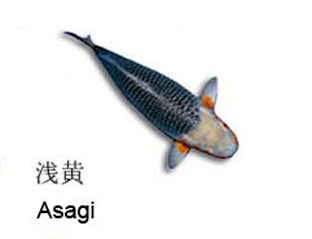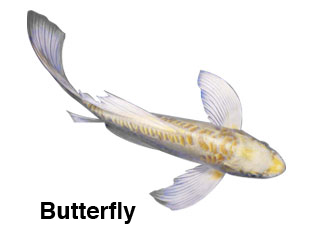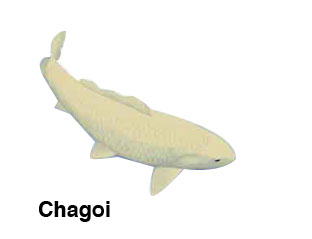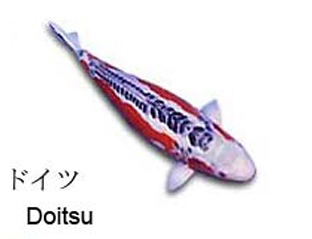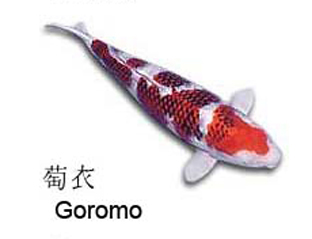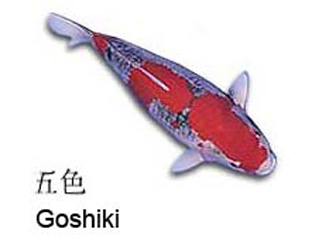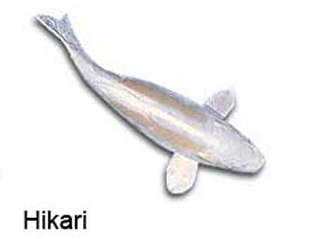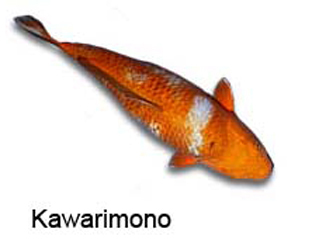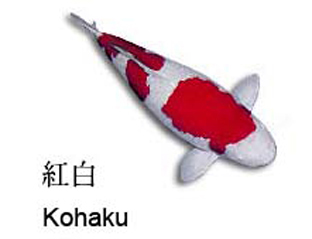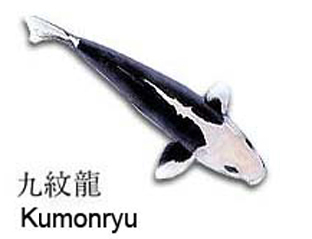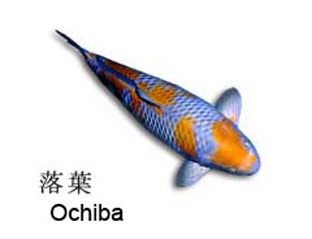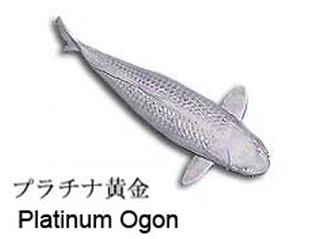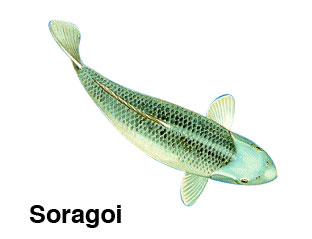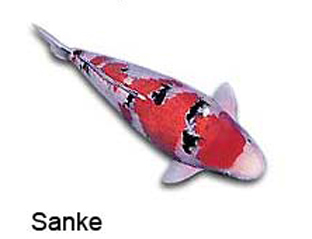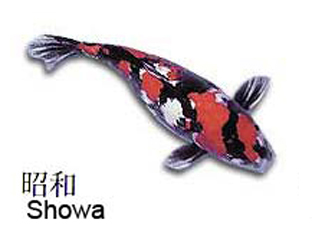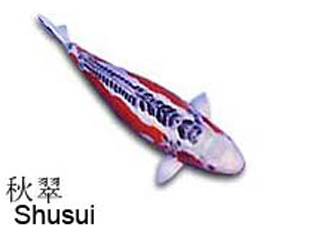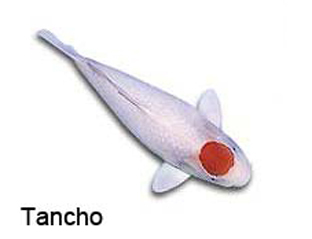Asagi koi is light blue above and usually red below, but also occasionally pale yellow or cream, generally below the lateral line and on the cheeks. The Japanese name means pale greenish-blue, spring onion color, or indigo. Konjo Asagi has a dark blue almost black back. Narumi Asagi has mid blue color to the back. Mizu Asagi has a light blue color to the back.
Bekko is a white, red, or yellow-skinned koi with black markings -sumi. The Japanese name means "tortoise shell".
Aka bekko is a red koi with black markings (Aka is another word for red).
Shiro bekko is a white koi with black markings.
Ki bekko is a yellow koi with black markings (rare variety). It may be confused with the Utsuri.
Butterfly koi is a hybrid of koi and Asian carp having the trait of long flowing fins and tail. Various colorations depend on the koi stock used to cross. This trait is a favorite in the United States with pond keepers for its dramatic fin/tail presentation and is being bred in most all varieties of koi.
Chagoi ( "tea-colored") this koi can range in color from pale olive-drab green or brown to copper or bronze and more recently, darker, subdued orange shades. Famous for its docile, friendly personality and large size, it is considered a sign of good luck among koi keepers.
Doitsu (or) Doitsu-goi, is the result of crossbreeding numerous different established varieties with "scaleless" German carp (generally, fish with only a single line of scales along each side of the dorsal fin). There are four main types of Doitsu scale patterns. The most common type (referred to above) has a row of scales beginning at the front of the dorsal fin and ending at the end of the dorsal fin (along both sides of the fin). The second type has a row of scales beginning where the head meets the shoulder and running the entire length of the fish (along both sides). The third type is the same as the second, with the addition of a line of (often quite large) scales running along the lateral line (along the side) of the fish, also referred to as "mirror koi". The fourth (and rarest) type is referred to as “armor koi” and is completely (or nearly) covered with very large scales that resemble plates of armor. They also are called Kagami-goi, or mirror carp.
GinRin (or) Kinginrin is a koi with the trait of metallic (glittering, metal-flake-appearing) scales. The name translates into English as "gold and silver scales"; it is often abbreviated to GinRin. There are GinRin versions of almost all varieties of koi, and they are fashionable. Their sparkling, glittering scales contrast to the smooth, even, metallic skin and scales seen in the Ogon varieties. Recently, these characteristics have been combined to create the new GinRin Ogon varieties.
Goromo - Koromo is a white fish with a Kohaku-style pattern with blue or black-edged scales only over the hi pattern. This variety first arose in the 1950’s as a cross between a Kohaku and an Asagi. The most commonly encountered Koromo is an Ai Goromo, which is colored like a Kohaku, except each of the scales within the red patches has a blue or black edge to it. Less common is the Budo-Goromo, which has a darker (burgundy) hi overlay that gives it the appearance of bunches of grapes. Very rarely seen is the Tsumi-Goromo which is similar to Budo-Goromo, but the hi pattern is such a dark burgundy that it appears nearly black.
Hikari Moyo-Mono This group contains all metallic koi not in any other class with two or more colors but aren't showa or utsuri. Yamato-nishiki is basically a metallic sanke. Kujaku are platinum koi with hi markings. The scales are overlaid with a matsuba pattern.
Platinum kohaku is a metallic kohaku. Kikisui is a doitsu platinum kohaku. Gin bekko is a metallic shiro bekko. Kinsui and ginsui are the metallic varieties of shusui. Hariwake are platinum with orange (orenji hariwake) or yellow (yamabuki hariwake) markings. They can be normally scaled, doitsu, (pine cone effect) or doitsu matsuba.
Showa Sanke (or) Shōwa Sanshoku is a black Koi with red (hi) and white (shiroji) markings. The first Showa Sanke was exhibited in 1927, during the reign of the Showa Emperor. In America, the name is often abbreviated to just "Showa". The amount of shiroji on Showa Sanke has increased in modern times (Kindai Showa), to the point that it can be difficult to distinguish from Taisho Sanke. Hi Showa is a predominantly red Showa. Kindai Showa has a predominantly white pattern. Tancho Showa has a red spot on the head and a black body with white markings.
Shūsui means "autumn green"; the Shūsui was created in 1910 by Yoshigoro Akiyama, by crossing Japanese Asagi with German mirror carp. The fish has no scales, except for a single line of large mirror scales dorsally, extending from head to tail. The most common type of Shūsui have a pale, sky-blue/gray color above the lateral line and red or orange (and very, very rarely bright yellow) below the lateral line and on the cheeks. Hana Shusui has a band of red(hi) running up to the lateral line and light blue appears up to the dorsal line. Hi Shusui has red (hi) that spreads up to the dorsal line. Ki Shusui has the red (hi) replaced by yellow (ki).
Tsurimono (or) Utsuri is a black koi with a white, red, or yellow markings, in a zebra color pattern. The oldest attested form is the yellow form, called "black and white markings", in the 19th century, but renamed Ki Utsuri by Elizaburo Hoshino, an early 20th-century koi breeder. The red and white versions are called Hi Utsuri and Shiro Utsuri, respectively. The word utsuri means to print (the black markings are reminiscent of ink stains). Genetically, it is the same as Showa, but lacking red pigment.
 Beatutiful and Fun, Koi make any garden a place of delight and serenity
Beatutiful and Fun, Koi make any garden a place of delight and serenity



 1
1 2
2 3
3 4
4 5
5